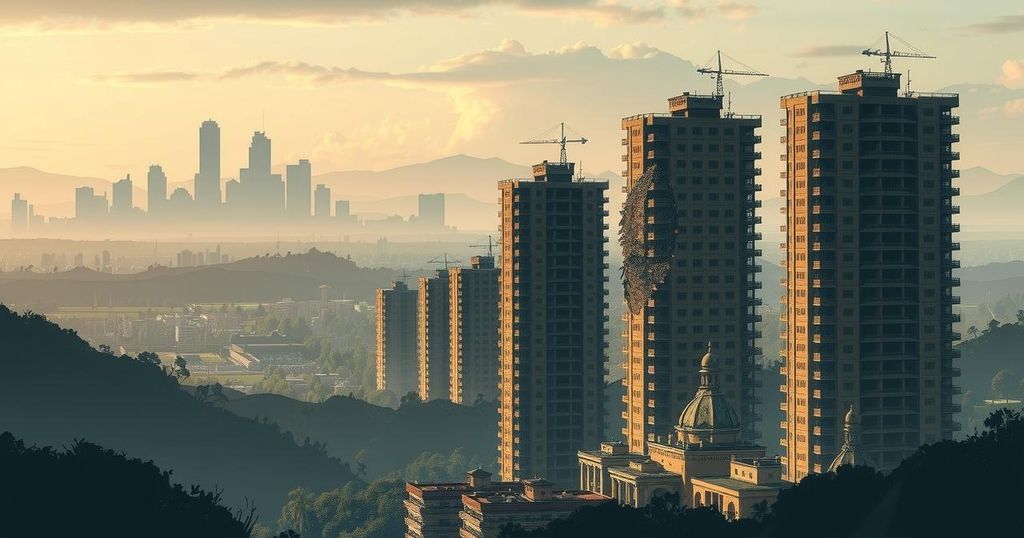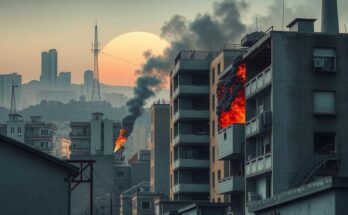Goma, a city in eastern DR Congo, has recently fallen under the control of M23 rebels after intense fighting, resulting in significant casualties and injuries. The M23 claims to represent ethnic Tutsi minority rights while facing accusations of seeking mineral wealth control. The health facilities are overwhelmed with wounded, and the local economy suffers due to fear and displacement of residents. Conditions remain tense as the M23 seeks further territorial gains in the region.
Upon entering Goma, a city in the eastern region of the Democratic Republic of the Congo (DR Congo), the atmosphere felt deceptively normal, with residents engaging in daily activities such as commuting and street trading. However, a stark reality emerged as armed fighters from the M23 rebel group began to assert their control, having recently captured the city last week after intense clashes with the DR Congo army. This conflict has resulted in significant casualties, with reports indicating at least 700 deaths and nearly 3,000 injuries from the fighting.
The M23 group, which consists mainly of ethnic Tutsis, claims to be advocating for minority rights, while the Congolese government accuses them of seeking dominance over the region’s mineral resources, particularly amid ongoing tensions exacerbated by alleged Rwandan support for the rebels. At a checkpoint controlled by M23 fighters, travelers faced scrutiny, yet the presence of the rebels felt normalized without a visible military presence from the Congolese forces.
At a local hospital treating those injured in the violence, the echoes of pain were palpable. Dr. Nathaniel Cirho found himself a patient after sustaining injuries from shrapnel during a bomb blast that devastated his neighborhood. Meanwhile, an elderly woman recounted her harrowing experience, having self-treated her gunshot wound for days before receiving assistance only after being escorted by M23 fighters.
Despite some medical staff managing to treat hundreds of patients, the hospital is now overwhelmed, handling over 700 casualties from various violent injuries. This includes not only physical wounds but also victims of sexual violence, reported as a tactic of warfare within the ongoing strife, echoing the concerns of the UN Office of the High Commissioner for Human Rights.
While parts of Goma exhibit signs of life returning, many areas remain paralyzed by fear. Business owner Sammy Matabishi expressed concern about the lack of customers, attributing it to displaced residents fleeing to neighboring countries. Despite the grim reality, some individuals appear to have resigned themselves to the M23’s authority as they navigate their daily lives under rebel control.
The rebels have established their dominance by occupying government offices and strategically surveying the city. Observations indicate a clear absence of Congolese army presence, with reports of soldiers abandoning their positions amidst the assault. M23’s ultimate goal appears to be the further southward advance toward the city of Bukavu and possibly toward the national capital, Kinshasa.
The current situation in Goma arises from a complex backdrop of ethnic conflict and competition for resources in the eastern DR Congo region. The M23 rebel group has historically sought autonomy and recognition for minority rights, particularly for ethnic Tutsis. This latest escalation follows a history of violence in the area, driven by long-standing tensions involving various armed groups and the involvement of neighboring countries, particularly Rwanda. The humanitarian impact of this conflict has been profound, leading to widespread displacement, injuries, and fatalities among the civilian population, and drawing considerable international attention.
Goma’s current state reflects the dire consequences of ongoing conflict fueled by both local and external influences. The M23 rebels’ control brings about a precarious situation for residents, manifested in fear and instability. Despite some semblance of business returning, the persistent threat of violence looms over the community, demonstrating how fragile peace remains in the region. Continued monitoring and dialogue may be necessary to address the humanitarian crises and underlying issues contributing to the conflict.
Original Source: www.bbc.com




